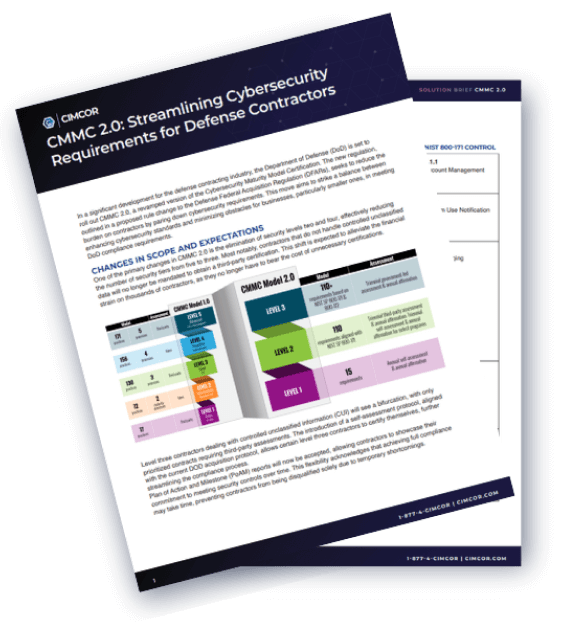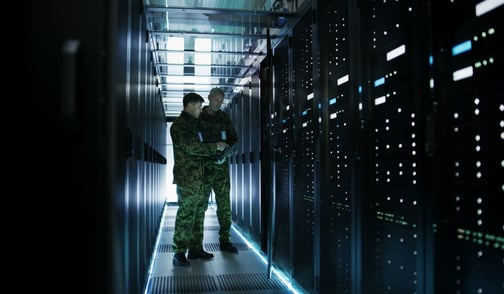The Cybersecurity Maturity Model Certification (CMMC) provides a structured approach to safeguarding sensitive information and ensuring the resilience of defense supply chains. Whether you're a defense contractor navigating compliance or an organization aiming to bolster your cybersecurity posture, understanding the basics of CMMC is the first step toward success.
CMMC 2.0, the revamped version of CMMC, is currently underway with a phased implementation in place. All DoD contracts require certification that meets the requirements in the updated standard, and many organizations face the challenge of revamping their cybersecurity program before the deadline in October 2025. In this post, let's go over the details of the update and additional steps to help you succeed in your journey to CMMC compliance.
What's Needed for CMMC Compliance?
To do business with government entities, the DoD requires organizations to achieve and maintain compliance with CMMC standards. Here are some key components businesses should be sure to cover:
Understand NIST 800-171 Controls Clearly
The CMMC 2.0 update aligns very closely with NIST 800-171. As NIST 800-171 is already required for most businesses, there shouldn't be too much of a gap in taking on CMMC 2.0 compliance. Be aware—if you think you're compliant with CMMC and NIST now, that may change in the upcoming months when NIST releases Revision 3 of 800-171.
Reporting
Like any compliance audit, comprehensive reporting is essential in proving compliance with CMMC. Having advanced tools with automatic reporting features can make a world of difference. Some tools can even prepare your reports in a way that auditors would prefer to see them, saving your team a significant amount of time and effort.
Assessment
CMMC assessments allow the DoD to verify the implementation of the required cybersecurity standards. Depending on the level of compliance needed, an organization can either conduct a self-assessment, go through a Third-Party Assessor (C3PAO), or have their assessment conducted by a government official.
While a lot is involved in ensuring your CMMC compliance efforts are successful, following the steps below is a great place to start
Step 1: Define Your CMMC Level
Before organizations can start preparing for CMMC, it's critical to understand what level of compliance you're required to achieve. The release of CMMC 2.0 has changed the typical structure contractors and subcontractors have used previously. While the levels have decreased from five to three, the requirements themselves aren't unfamiliar.
CMMC 2.0 Levels:
- Level 1 - Requires the basic controls needed for essential cyber hygiene. This level of certification will be needed by contractors that hold or process mildly sensitive content such as Federal Contract Information (FCI).
- Level 2 - Represents a moderate standard of cyber hygiene for an established organization and requires all 110 NIST controls with an additional 20 controls from various sources. This level will be required for most DoD contractors that hold or process Controlled Unclassified Information (CUI).
- Level 3 - Contractors must have a fully mature cybersecurity function across all 43 capabilities.
Step 2: Assess Your Cybersecurity Posture
Having a solid understanding of your current cybersecurity systems, weaknesses, and maturity level can help you evaluate how much you really need to prepare for the CMMC Certification. If your organization incorporates routine cybersecurity posture assessments, you can be that much closer to achieving and maintaining compliance with CMMC.
Related Read: Assess Your Cybersecurity Posture in 5 Easy Steps
Step 3: Conduct a Gap Analysis
Organizations aiming to comply with CMMC can find it challenging to determine where their gaps lie. Internal and external assessments can be helpful in identifying areas of non-compliance. However, these assessments are only good at the time they are conducted. Continuously monitoring for non-compliance is key to ensuring your systems maintain compliance with CMMC and other regulatory requirements.
The CMMC 2.0 update aligns more closely with NIST 800-171 standards than the previous version, so ensuring your organization is aligned with the requirements is critical. NIST 800-171 Revision 3 will be released in the spring, so if you are currently aligned with the standard, compliance may have to be revisited once the update is released.
For more information on the NIST 800-171 R3 update and how compliance with CMMC 2.0 may be affected, see CMMC 2.0 Cybersecurity Requirements for Defense Contractors.
Step 4: Identify Cost
CMMC compliance is not a quick and easy process. From changes to processes and personnel to the cost of new systems and expert consultancy, it isn't cheap either. It is essential for organizations to be prepared for the cost of compliance before getting started.
Several factors contribute to the cost of CMMC compliance. In preparing for your assessment, setting up and maintaining systems and processes required to produce compliance evidence will take the most time and resources. Additionally, your organization's size and level of required compliance will largely contribute to the overall cost.
For more information, refer to ANSWERED: How Much Does CMMC Certification Cost?
Streamline CMMC Compliance
While there's no silver bullet when it comes to achieving CMMC compliance, advanced tools like CimTrak can help make the process seamless and stress-free. CimTrak is an IT integrity, security, and compliance tool that makes it easy for organizations to substantially improve cybersecurity maturity.
CimTrak's functionality directly maps to many of the key control objectives of CMMC.
| AC | Access Control | RE | Recovery |
| AM | Asset Management | RM | Risk Management |
| AU | Audit & Accountability | SA | Security Assessment |
| CM | Configuration Management | SC | System & Communication Protection |
| IR | Incident Response | SI | System & Information Integrity |
To learn more about how CimTrak can help your organization achieve and maintain compliance with CMMC 2.0 standards, download the solution brief or speak to one of our security experts today.
Tags:

March 5, 2024



